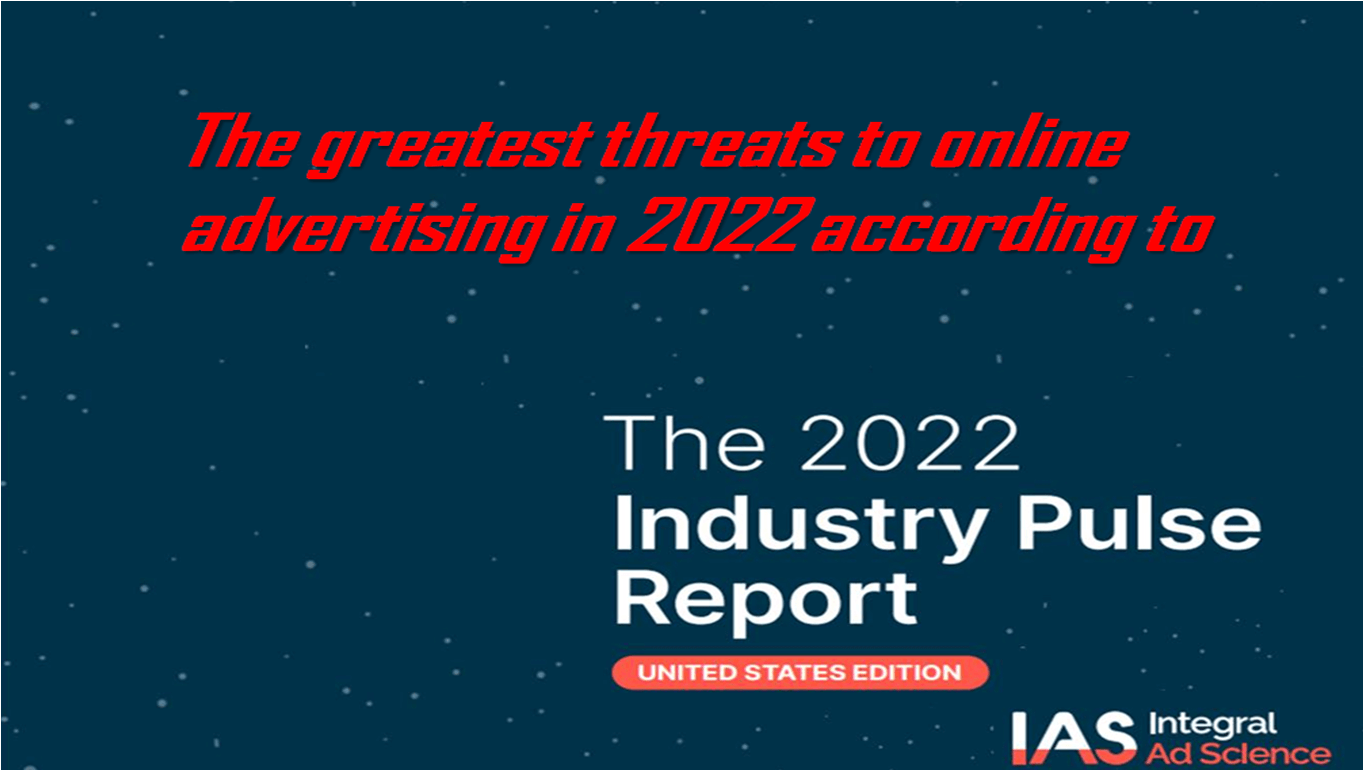The greatest threats to online advertising in 2022 according to The 2022 Industry Pulse Report.

source: own elaboration
We wrote about the Industry Pulse Report prepared by Integral Ad Science in the previous article. In it, we discussed the topic of marketing channels in which marketers will most likely invest in 2022, but now we must deal with the threats that this year will bring to online advertising, according to the experts surveyed for this study. 230 US advertisers / brands, publishers, media agencies, ad networks and other entities related to the marketing industry agreed to answer the questions in the online survey. Excerpts from the report on ad frauds, Brand Safety and other threats that can be encountered in 2022 will be mentioned in the text below.
Main challenges related to digital media
Inter alia, the respondents were asked „Which of the following will be major digital media challenges for your organization in the next 12 months? (Select up to three)”. Almost every third respondent (32%) indicated the answer - poor viewability levels, every fourth (27%) - data privacy legislation, and almost every fourth of them (24%) - fake news and misinformation. The following responses were selected: programmatic media buying/selling - 23%, contextual targeting - 21%, assessment of campaign ROI - 20% and ads delivering alongside risky content - also 20%.
Viewability is one of the most important parameters describing advertising on the Internet, which determines what part of the advertising space and for how long was visible and thus could be actually seen by the user. Contrary to the number of views of the advertisement, its viewability tells us whether the message was physically on the screen, in the active browser tab, in the visible part of the page. In accordance with the adopted standards, an advertisement is considered viewable, with half of the surface visible on the screen for at least one second (for display advertising) and half of the player’s surface of the video advertisement for two continuous seconds during the playing of the advertisement. Viewability is usually given as a percentage and tells us what percentage of ad impressions met the viewability criteria. Messages placed at the top of the page or with a large amount of text will have a higher level of viewability, but the visibility of the advertisement can also be increased thanks to the use of the lazy load mechanism (loading the advertisement only when the user scrolls the page to the place where the advertisement is to be displayed) or if the file with the advertisement is lighter. It was the problem of making advertisements not only displayed, but above all visible to the recipients, that was most often indicated by the respondents as a challenge related to conducting marketing campaigns in digital media.
For several years, there has been a lot of talk about the withdrawal of third-party cookies and other measures to protect consumer privacy and give them more control over their personal data. However, the development of legislation in this area isn’t always in the marketers’ best interests. They have to adapt quickly to the new situation, and almost all targeting is based on the collection and processing of consumer data, often containing very detailed one. Therefore, it shouldn’t come as a surprise that one in four experts (27%) identified data privacy legislation as a challenge.
The third most frequently chosen answer - fake news and misinformation, was chosen by 24% of the respondents. Last week, we have already learned how important fake news will play in 2022. As the Polish Government Center for Security warns, Russia’s aggression against Ukraine isn’t only of a military nature - it is also cyberwar and disinformation. Russian propaganda against Ukraine has encompassed at least six different false lines of narrative, and this is probably just the beginning.
Media most exposed to ad frauds and brand risk
The expert survey also asked „in your opinion, which of the following media types will face serious challenges across the media industry in the next 12 months? (Select up to three)”. Almost half of the respondents (47%) indicated Social Media, and slightly more than 3 out of 10 respondents (31%) chose Linear TV. The answers „Digital radio” were given by 27% of the experts participating in the survey. Other variants obtained, respectively: „Mobile app” - 24%, „Video Games” - 23%, „Mobile web” - 22%, „Podcasts” - 20%, „Connected tv” - 18%, and „Digital video” excluding „Connected TV” - 17%. Most of the results were similar to those obtained in a similar survey conducted for 2021 (the exception here is „Podcasts”, which respondents couldn’t choose a year earlier), but there are exceptions. A year earlier, the most frequently indicated answer in this question was Linear TV - as many as 55% of experts believed that it would face serious challenges in 2021 (it is worth adding that with the gigantic increase in the popularity of connected TV and OTT, they were certainly right), and only 10 % of experts thought it would be the same for Digital radio. Likewise, only 2% of them chose video games as the answer.
Of course, the survey also included many additional questions, so it can be concluded that the vast majority of respondents - 79% - agree with the statement that „ad fraud is a concern when running social media campaigns”, and only 2% less (77%) that „ad fraud will be a greater concern across mobile environments regardless of advertising format”. When it comes to digital radio, 81% of respondents said that „third-party verification will be important to ensure the quality of audio streaming inventory” and 72% that „Brand risk around audio streaming content will increase as additional inventory becomes available”.
When asked „which of the following media types will be most vulnerable to ad fraud in the next 12 months? (Select up to three)”, the majority of respondents (54%) indicated Social Media. This answer was chosen by far the most frequently. The answer „Search” was in second place with a result of 24%, and in the third place, the answer „Mobile video” chosen by every 5th respondent, while Mobile web video was indicated by 21%, and Mobile in-app video by 20% of respondents. The rest of the results was as follows: Mobile web display - 19%, Video games - 18%, Mobile in-app display - 16%, Desktop display - 14%, Desktop video - 14%, Programmatic advertising - 14%, Digital radio - 12%, Podcasts - 11% and Connecten TV - 10%.
The situation is quite similar in the case of the corresponding question regarding the brand risk. Most, as many as 49% of respondents, said that Social Media would be exposed to brand risk incidents in 2022. The second place, with a result of 24%, was taken by Mobile web video, and the third place (23%) was taken by „Search” response. Then we have: Mobile in-app video -20%, Programmatic advertising - 19%, Connected TV - 17%, Mobile web and in-app display - also 17% each, Desktop video - 16%, Desktop display - 14% , Video games - 14%, Podcasts - 13% and Digital radio - 12%.
Of course, the above results can be interpreted in many ways - it all depends on the point of reference. However, we can safely say that according to the surveyed experts, advertising in Social Media (and as we wrote in the previous text, it was the second most-chosen marketing channel) are the most vulnerable to ad frauds and brand risk. The respondents, having the option of selecting up to 3 answers in both questions, chose very different variants of answers - so they perceive (although of course with different frequency) threats in each of the mentioned types of digital advertising.
Responsibility for counteracting advertising fraud
The survey also raised a very interesting question „thinking ahead to 2022, who should be in control of ad fraud mitigation efforts across the digital advertising industry? (Drag and drop to rank from 1=most in control to 7=least in control)”. All seven responses obtained very similar results (from a maximum of 35 percentage points to a minimum of 20). Verification tech providers have been identified as having the greatest responsibility for reducing advertising fraud. Next, the respondents most often mentioned Publishers, Brands and Agencies, followed by ISP, SSP and DSP.
Interestingly, for a similar question regarding the brand risk, completely different results were obtained. In this case, although the responses also received a very similar number of indications (from a maximum of 37 to a minimum of 19 percentage points), the respondents believed that the most control when it comes to measures limiting the brand risk should have... the brands themselves. Then, mentioned were Agencies, ISP, Publishers, Verification tech providers, SSP and DSP.
It can therefore be said that, according to experts, the quality of the media is becoming a team effort, and the responsibility for preventing ad frauds and limiting the brand risk should be shared between various entities in the digital advertising industry.

